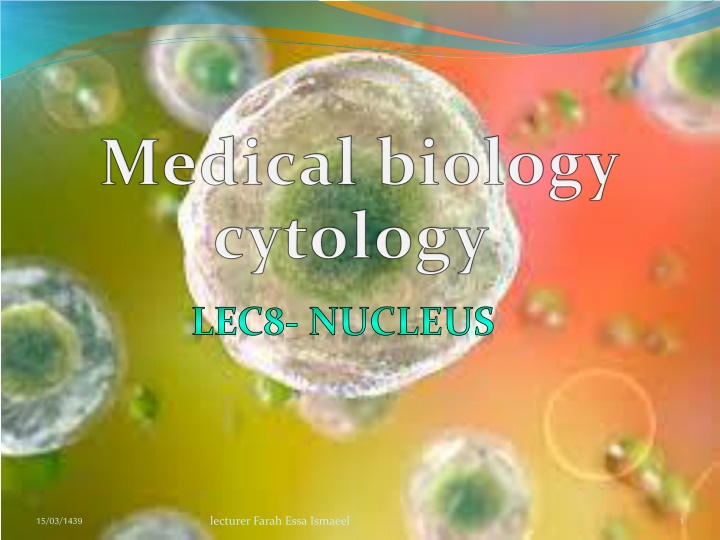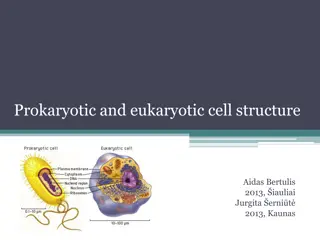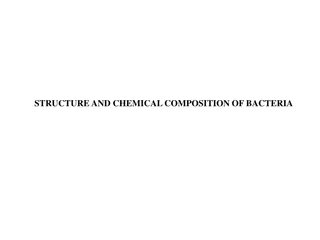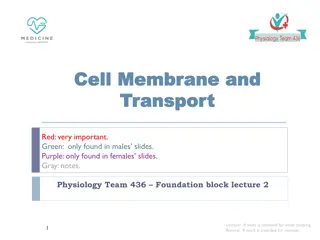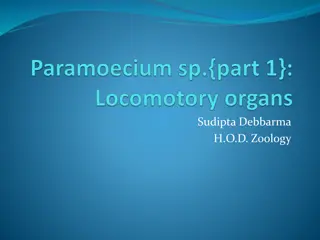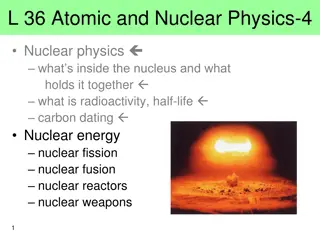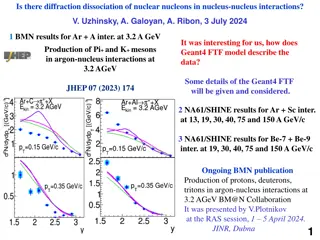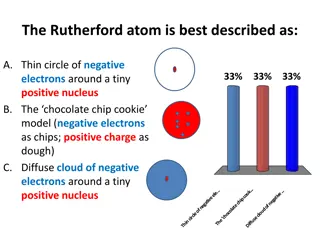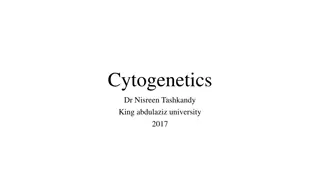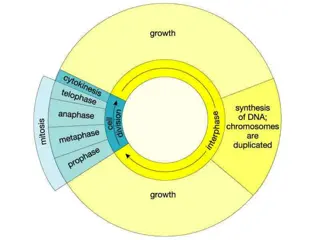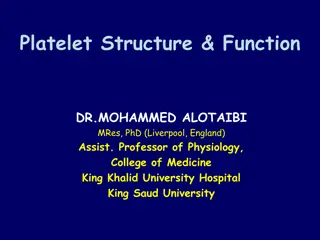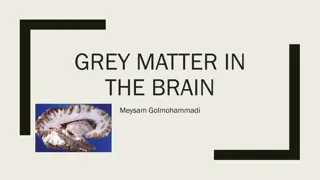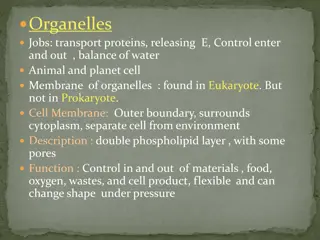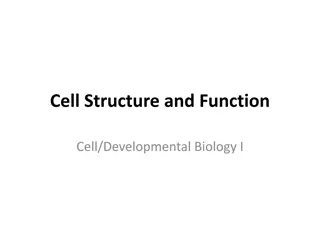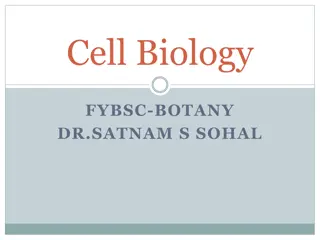the Cell Nucleus: Structure, Function, and Ultrastructure
The cell nucleus, a vital organelle in eukaryotic cells, contains genetic information and regulates cellular processes. Explore its structure, location within the cell, and distinct components like the nuclear envelope, nucleolus, and chromatin network. Learn about the diverse appearances of nuclei under light and electron microscopes. Delve into the role of the nucleus as the command center of the cell, governing growth, reproduction, and cellular activities. Gain insights into mononucleated, binucleated, and multinucleated cell variations, highlighting the nucleus's significance in cell biology.
Download Presentation

Please find below an Image/Link to download the presentation.
The content on the website is provided AS IS for your information and personal use only. It may not be sold, licensed, or shared on other websites without obtaining consent from the author.If you encounter any issues during the download, it is possible that the publisher has removed the file from their server.
You are allowed to download the files provided on this website for personal or commercial use, subject to the condition that they are used lawfully. All files are the property of their respective owners.
The content on the website is provided AS IS for your information and personal use only. It may not be sold, licensed, or shared on other websites without obtaining consent from the author.
E N D
Presentation Transcript
LEC8- NUCLEUS 15/03/1439 1 lecturer Farah Essa Ismaeel
Nucleus The cell nucleus is a membrane-bound structure that contains a cell's hereditary information and controls its growth and reproduction. It is the command center of a eukaryoticcell and is usually the most notable cell organelle in both size and function. 15/03/1439 2 lecturer Farah Essa Ismaeel
The nucleus The nucleus (nuclei, plural) the largest component of a cell, frequently appears as rounded, oval, flat, kidney shape, horse shoe shape, segmented structure. Position of nucleus often near the center of the cell but in some nucleus located eccentric, basal or peripheral. or lobulated cells the 15/03/1439 3 lecturer Farah Essa Ismaeel
The nucleus Found in all eukaryotic cells except mature red blood cells of mammals do not have a nucleus, or are non-nucleated. Most cells have a single nucleus called mononucleated, some cells have two nucleus called binucleated as in liver cells (hepatocyte) or other cells may exhibit multiple nuclei called multinucleated as osteoclastand skeletal muscles. 15/03/1439 4 lecturer Farah Essa Ismaeel
L.M. the light microscopic appearance of nucleus is basophilic; it may either be lightly stained (vesicular) like the nucleus of neuron (nerve cells) or be deep stained the details of its component are not seen like the nucleus of lymphocyte. 15/03/1439 5 lecturer Farah Essa Ismaeel
Ultrastructure of nucleus (E.M.) The nucleus of a non dividing cell consists of the following components: 1. Nucleolemma or nuclear membrane (karyotheca) 2. Nuclear sap or karyolymph or nucleoplasm 3. Chromatin network or fibres 4. Nucleolus 5. Endosomes. 15/03/1439 6 lecturer Farah Essa Ismaeel
15/03/1439 7 lecturer Farah Essa Ismaeel
Nuclear Envelope or nuclear membrane 15/03/1439 8 lecturer Farah Essa Ismaeel
Nuclear Envelope or nuclear membrane The nuclear envelope forms a selectively permeable barrier (double membrane) between the nucleus and cytoplasmiccompartments. Electron microscopy reveals that the envelope has two concentric membranes The outer one is called ectokaryotheca and inner one is termed endokaryotheca separated by a narrow perinuclearspace. This space and the outer nuclear membrane are continuous with the extensive cytoplasmic network of the rough endoplasmic reticulum. 15/03/1439 9 lecturer Farah Essa Ismaeel
Nuclear Envelope or nuclear membrane Nuclear envelope closely associated with the inner nuclear membrane is a highly organized meshwork of proteins called the nuclear lamina which stabilizes the nuclear envelope. Major components of this layer are the class of intermediate filament proteins called lamins that bind to membrane proteins and associate with chromatin in no dividing cells. 15/03/1439 10 lecturer Farah Essa Ismaeel
Nuclear Envelope or nuclear membrane The inner and outer nuclear membranes are bridged at nuclear pore complexes. Various core proteins of a nuclear pore complex called nucleoporins. Although ions and small solutes pass through the channels by simple diffusion, the pore complexes regulate movement of macromolecules between the nucleus and cytoplasm. Macromolecules shipped out of the nucleus include ribosomal subunits and other RNAs associated with proteins, while inbound traffic consists of chromatin proteins, ribosomal proteins, transcription factors, and enzymes. 15/03/1439 11 lecturer Farah Essa Ismaeel
Medical Application Certain mutations in the gene coding for lamin A are associated with a subtype of the disorder progeria, which causes premature aging. 15/03/1439 12 lecturer Farah Essa Ismaeel
Functions of nuclear envelop regulate the entry of some proteins (histone and hormones) to the nucleus and export of RNAs from nucleus to the cytoplasm. encloses the nucleus and separates the genetic material of thecell from the cytoplasm of the cell. it serves as a barrier to prevent passage of macro- molecules freely between the nucleoplasm and the cytoplasm. 15/03/1439 13 lecturer Farah Essa Ismaeel
Chromatin network or fibres Chromatin is the combination of DNA molecules and proteins that make up the chromosomes. Chromatin can coil tightly to form visible chromosomes during cell division. Most of the time, however, the chromatin is uncoiled. Individual chromosomes distinguished and the chromatin appears grainy micrographs of the nucleus. cannot be in electron 14
15/03/1439 15 lecturer Farah Essa Ismaeel
Nucleoli (sing. Nucleolus) Micrographs of a nucleus do show one or more dark regions of the chromatin with spongy appearance. 15/03/1439 16 lecturer Farah Essa Ismaeel
Nucleoli (sing. Nucleolus) The nucleolus is a generally spherical, highly basophilic subdomain of nuclei in cells. The nucleolus is not surrounded by a membrane, it is a densely stained structure found in the nucleus. The intense basophilia of nucleoli is due not to heterochromatin but to the presence of densely concentrated ribosomal RNA (rRNA) that is transcribed, processed, ribosomal subunits in nucleoli. and complexed into 15/03/1439 17 lecturer Farah Essa Ismaeel
Nucleoli (sing. Nucleolus) Molecules of rRNA are processed in the nucleolus and very quickly associate with the ribosomal proteins imported from the cytoplasm via nuclear pore complexes. The newly organized small and large ribosomal subunits are then exported back to the cytoplasm through those same nuclear pores, the ribosome some time called mature RNA. Function of nucleolus is ribosome assembly 15/03/1439 18 lecturer Farah Essa Ismaeel
Nuclear sap or karyolymph or nucleoplasm Chromatin is immersed in a semi fluid medium called the nucleoplasm. A difference in pH suggests that nucleoplasm has a different composition from cytoplasm. The nucleus contains a transparent, semi-solid, granular and homogeneous matrix during interphasecalled as nuclear sap or karyolymph. karyolymph is a fluid substance containing many particles and network. Primarily it is composed of proteinous material and is the main site for enzyme activity. This nuclear sap also shows variable appearance during different stages of cell division. 19
Nuclear constituents The nucleus contains RNA, DNA, proteins of two kinds, histone and nonhistone; some lipids; various organic phosphorus compounds; and various inorganic compounds, mostly salts. 15/03/1439 20 lecturer Farah Essa Ismaeel
Functions of nucleus It controls the heredity characteristics of an organism. It is responsible for regulation of protein synthesis, cell division, growth and differentiation. Stores heredity material in the form of deoxy-ribonucleic acid (DNA) strands. Also stores proteins and ribonucleic acid (RNA) in the nucleolus. It is a site for transcription process in which messenger RNA (m RNA) are produced for protein synthesis. Nucleolus produces ribosomesand known as protein factories. It also regulates the integrity of genes and gene expression. 15/03/1439 21 lecturer Farah Essa Ismaeel
15/03/1439 22 lecturer Farah Essa Ismaeel
